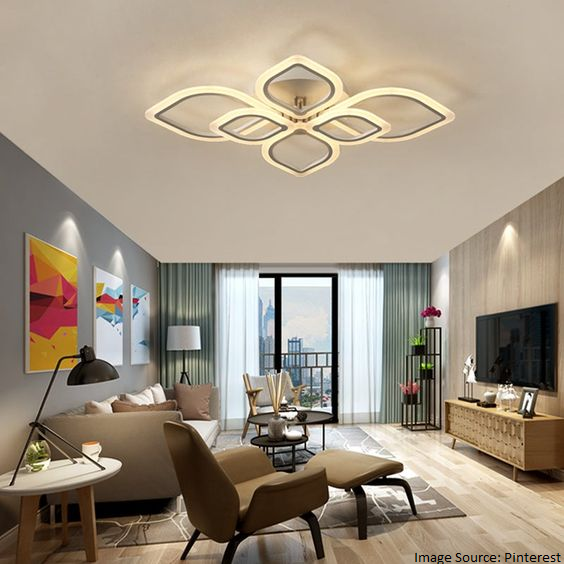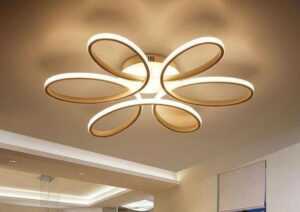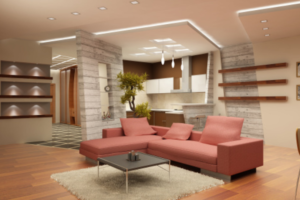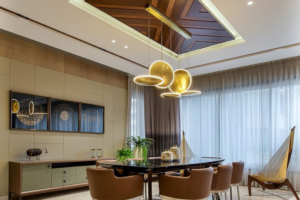A false ceiling is distinct from a conventional ceiling comprised of artistic components like tiles, PVC panels, and gypsum board, among others. The space between the actual ceiling and the false ceiling is empty. In order to increase soundproofing in halls and auditoriums, false ceiling designs are a fantastic thing to utilize. The false ceiling is connected to the old ceiling with metal wires. When the floor height exceeds ten feet, there is a one-foot gap between the ceiling and the false ceiling. A metal grid that is suspended and maintained by the original ceiling serves as a false ceiling.
In the home, false ceilings come in a range of sizes and shapes. Based on the intended function, materials, appearance, and visibility of the false ceilings, many categories have been created. On the other hand, the materials used must be categorized according to the most common categories. The following list includes the most popular types of false ceilings.

Plaster of Paris (POP) False ceiling Designs
One of the most often utilized materials in both commercial and residential roofing applications is the plaster of Paris (POP). POP is just gypsum that has been heated to the point where the water evaporates, leaving out the water content. When water is added, it hardens and works well as ceiling material. POP is extremely durable, maintenance-free, and a strong insulator against both heat and cold. POP false ceilings may accommodate a variety of styles and finishes, including a uniform and smooth finish and designs in a variety of forms. It’s a great material for boosting lighting as well. The primary disadvantage of POP is its propensity to crack with time.
Wooden False Ceiling Designs
Some homeowners like peace and natural beauty in the interiors of their homes. The best way to achieve this rustic look is using wooden beams on the ceiling. The ceiling can be decorated with a variety of designs created by these wooden panels, which gives it a contemporary and attractive aspect. Wooden false ceilings make excellent room focal points as well. Modern homes are increasingly embracing wooden false ceilings because of their organic textures and shapes. These ceilings receive a variety of treatments to enhance their aesthetic appeal. Artificial wooden ceilings are made using hollow wooden blocks, wooden panels, wooden boards, and plywood. This form of ceiling is preferable for locations with cold climates since it is simple to assemble wooden pieces using nails and screws.
PVC Artificial Ceilings
PVC is formally known as polyvinyl chloride. It is one of the inexpensive and lightweight false ceiling materials that homeowners choose. PVC panels are used to clothe the external walls of both residential and commercial structures. PVC is durable plastic, and because it is manufactured in a factory, the finished product has a flat surface. Depending on the needs, it can be created in any desired shape and size.
PVC is a very water-resistant material, making it the ideal answer for issues with water leakage through ceilings. In comparison to other forms of artificial ceilings, it is lightweight, termite-proof, and requires very little care.
Metal False Ceiling Designs
False ceilings frequently use metals like galvanized iron and aluminum. Metals are brittle and long-lasting by nature. These ceiling panels are simple to install and very low maintenance. They are perfect for housing electrical lines, air conditioning ducts, and water pipes out of sight because they are also simple to remove and reinstall. Innovative finishing techniques can be used on metal ceiling panels to improve their aesthetic appeal.
Fiber false ceilings are becoming more and more common in business spaces since they are inexpensive, simple to install, and have numerous practical benefits. Fibre ceiling panels, however, are unattractive and therefore unsuitable for residential use.
Fiber Artificial Ceilings
Fibre artificial ceilings are becoming more and more popular since they are inexpensive and simple to install. For commercial applications like showrooms and other spaces, fiber ceilings are constantly in high demand.
These false ceiling styles are created by combining natural and artificial materials like stone, bitumen, wood, and vegetable fiber.
These materials are suitable where heat and sound insulation are crucial since they offer greater insulation qualities. Fibre ceiling tiles are manufactured in a variety of forms, dimensions, and patterns.




